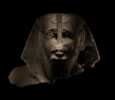Head of a King
Head of a King
Bust of Amenhotep III, re-employed by Ramses II
Egypt
1540-1190 B.C., 18th/19th Dynasty
Limestone
H: 36.7 cm, W: 48.3 cm
Sold
Monumental head of an Egyptian king, originally most likely Amenhotep III, 1390-1353 B.C., later re-cut and re-employed by Ramesses II, 1279-1213 B.C. Wearing a broad beaded collar and striped nemes-headcloth with fragmentary queue behind. The uraeus and postiche missing, with the incised beard-strap lines still visible. A circular recess is cut into the top of the head, probably to hold the Crown of Upper and Lower Egypt.
The hard cream-coloured stone from which this head is carved was particularly favoured by Amenhotep III, however, the head bears evidence of modification. The carved vertical recess on the front of the head would have served to secure the addition of a nose, and the alteration and addition of an uraeus designated by Ramesside stylistic preference. The apparent addition of other royal accoutrements, perhaps streamers or additional cobras, is suggested by several narrow drilled recesses on the sides and back of the head. Another modification is the indication of recesses to indicate pierced ears, which did not appear in royal statuary until the time of Amenhotep III’s son, Akhenaten, and his successors. The drilled recesses at the corners of the lips visually assisted the transformation of what was originally a wider mouth to the smaller mouth preferred by King Ramesses II.
Amenhotep III, father of Akhenaten and grandfather of Tutankhamun, presided over a rich and prosperous reign of almost thirty-nine years which saw a flowering of grand art and architecture, best exemplified by the two enormous statues of the king outside his mortuary temple Thebes, known since classical Greek times as the Colossi of Memnon.
Günther Roeder, Hermopolis 1929-1939; Ausgrabungen der Deutschen Hermopolis-Expedition in Hermopolis, Ober-Ägypten, in Verbindung mit zahlreichen Mitarbeitern, 1959, pp. 11 and 257, pl. 43 f.
Most likely from Hermopolis.
Recorded in March 1930 by Günther Roeder (1881-1966) as being in the possession of a local dealer named Gelâl in the village of al-Idara, later published in his 1959 book.
Private Collection of Eleanor Rixson Cannon (1896-1985), New York, prior to c. 1976.
Private Collection of Frances Lown Crandall (1927-2015), New York, who was a close friend of Eleanor Cannon’s and received this head from the above as a gift in the early 1970’s and certainly prior to c. 1976 (accompanied by a photograph of Frances’ son Christopher Crandall, aged 12, with the head in the background dated c. 1976 and a note, diary entry and photos of the statue from Richard Keresey of Sotheby’s dated August 1989). The head was kept at the family residence in Cherry Hill, NJ, until 1986 when it was moved to their new home in Brookfield, CT, before they moved again in 1994 to Princeton, NJ.
Thence by descent to her husband Maxson Crandall Jr. (1929-2016), July 15th, 2015.
Thence by descent to their children Maxson Ray Crandall III, Brooks Christian Crandall and Christopher Carson Crandall, December 19th, 2016, kept at the home of Christopher Crandall in West Milford, NJ.
ALR: S00223332, with IADAA Certificate, this item has been checked against the Interpol database.
This head was first recorded in March 1930 by the German Egyptologist Günther Roeder (1881-1966), who was engaged in an archaeological dig at Hermopolis at the time. He writes in his 1959 publication on the excavation that the head was at the time in possession of a local dealer named Gelâl in the village of al-Idara, and having been undoubtedly found on the Tell (meaning hill, presumably the ancient site). It is one of a number of such objects that Roeder records as having been found by locals outside of the sanctioned dig. He describes how the inhabitants of the villages around the Tell found many such objects, and that good pieces were sold by them to museums and private collections.
The head is next recorded as being in the possession of Eleanor Rixson Cannon (1896-1985), in New York. She was an artist and collector who lived with her husband, Victor Hamlin Cannon, in Canyon Ranch, Woodstock, NY. She was part of the artists colony there, and is recorded as having a work included in an 1923 exhibition, alongside that of George Bellows. In 1932 she funded the publication of a small edition of Reeves Brace’s story ‘Within Silence’. Her husband Victor studied mining and was at one time supervisor of gold mines in Siberia. He first married a Russian woman, Kapa Chesnokova, from whom he separated, and in January 1936 he met Eleanor on a boat coming from Finland, marrying her seven days later. They developed land and farmed Aberdeen Angus cattle on their 109 acres along the Hudson before Victor died in 1950. Eleanor is mentioned in several lists of donors to major museums, including MOMA.
She was a close personal friend of Frances Lown Crandall (1927-2015), a watercolour painting and interior designer who was the niece of Charles Lang Freer, from whom she inherited a great love of the arts. She studied at Cornell, graduating with a degree in Human Ecology/Design and Environmental Analysis (Interior Design). She worked as an interior designer all her life, whilst also being an accomplished watercolourist, and was active in numerous historical and philanthropic societies, as well as being a talented and passionate equestrian.
Eleanor gifted Frances the head sometime in the early 1970s, and it remained within the family, passing to her husband, Max, when she died in 2015, and then their three sons on his death in 2016.










 Enquire
Enquire




